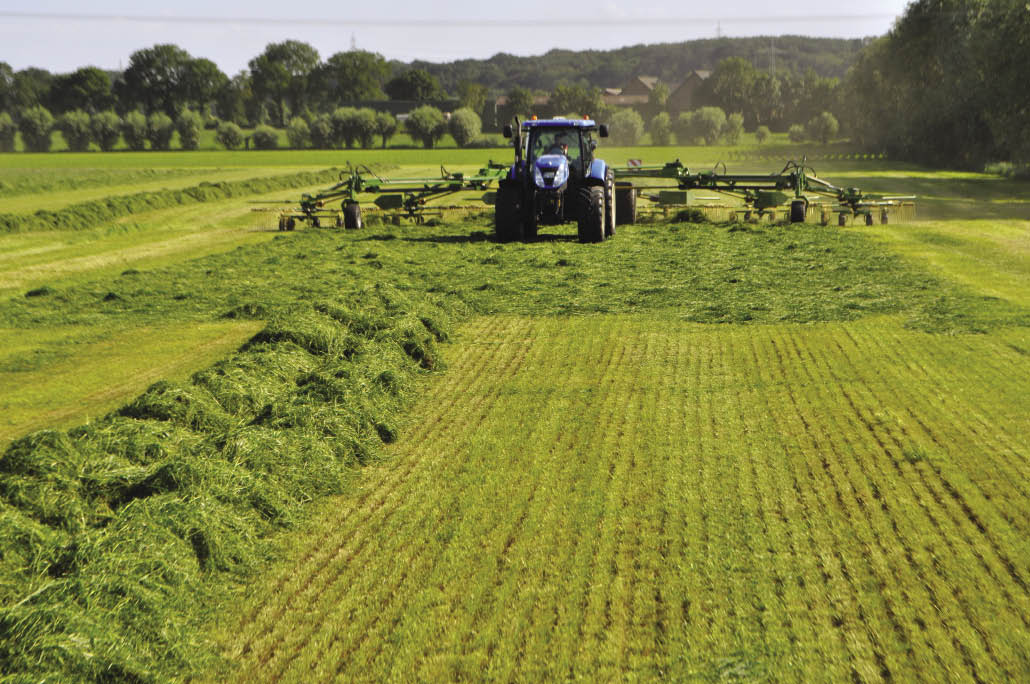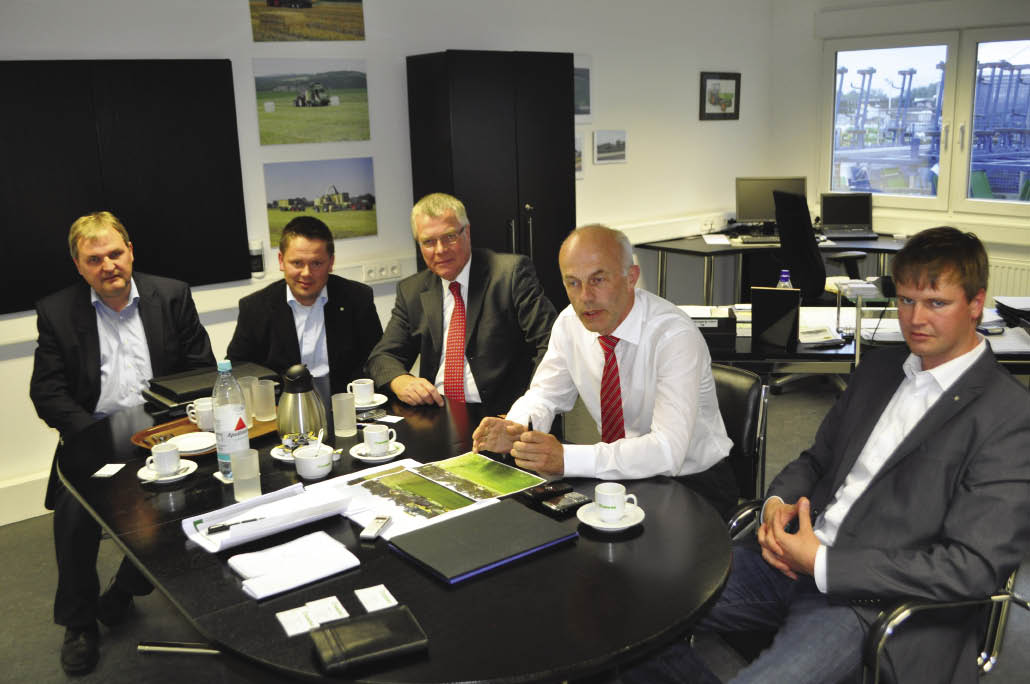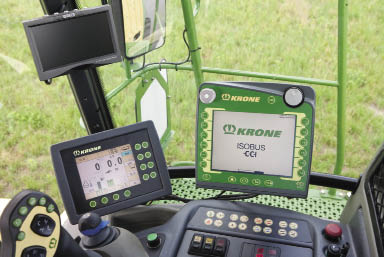
European manufacturers say they’re pushing to improve efficiency of haying operations by 15-20% in the next 5 years.
Mark Twain may have been in Europe when he said, “Buy land, they’re not making it anymore” because nowhere else is this more true.
Comparing North America’s situation to Europe’s when it comes to agricultural land use, Wilhelm Voss says, “Over here, the farms are much more restricted in land size, so the utilization of every acre is more intensive than it is in North America.”
Voss is managing director for marketing and sales worldwide for Krone, the manufacturer of hay and forage machinery based in Spelle, Germany.
With the need to get the most from every acre, or hectare, the brain trust at Krone says as hay and forage equipment is nearing its current limits in terms of size and speed, they’re looking to take the next leap in productivity. This, they say, will come by way of electronics.
Josef Horstmann, Krone’s general manager of R&D, says electronics will be the key to improving the overall efficiency of haying operations. Currently, he estimates that even the best European haying operations are only 65% efficient, with most falling in the 30-60% range. Horstmann expects this could be improved by 15-20% within the next 5 years by adapting the latest electronic technology to overall haying operations.
“We will use electronics as a tool to be more productive and more precise. The new tools will be able to deliver higher quality output, while enabling the customer to reduce his logistical costs and increase machine utilization,” Horstmann says.
This next wave of productivity gains in haying is already underway and is, in fact, an industry wide effort that includes many of Europe’s leading machinery manufacturers.
Taking Parallel Paths
Many of the same dynamics seen in the U.S. can be observed in German agriculture: fewer farmers but larger farms. Even at that, the scale of farming between the two countries is worlds apart. (See “Squeezed for Space,” p. 56.) For example, Germany has more than twice as many dairy cows than the two largest U.S. dairy states, California and Wisconsin, combined. But on average, its farms are much smaller in size. Along with its huge number of dairy cows comes the need for enormous amounts of forage to feed the herds, which drives Germany’s efforts of intensively working every hectare of ground. It’s a strategy that is gaining momentum in North America.
According to Krone executives, the haying practices of the two countries, while similar, are also somewhat different. According to Horstmann, U.S. and German farmers are following parallel paths.
“Europe is mainly a silage market, whereas North America is more of a dry hay market due to climactic conditions. American producers grow more alfalfa and a majority of what is grown here is grass. Other than this, I would say the trend is pretty much the same in that we see both countries going toward higher capacity machines that produce higher quality output. Farmers in both countries are looking more closely at the cost of ownership and demanding low maintenance costs. I believe these trends are pretty much the same in North America as they are in Europe,” Horstmann says.
To meet the growing needs for volume and efficiency, manufacturers have produced larger, faster equipment, some of enormous size. In recent years, the largest forage harvest manufacturers, Krone and Claas, have introduced twin-engine harvesters capable of producing more than 900 horsepower.
With Europe’s focus on silage, it has been the major market for the giant forage harvesters that have dominated the market for the last decade or more.
According to Andreas Afting, who is responsible for the development of hay tools for Krone, last year European producers purchased between 1,400-1,500 forage harvesters, about 600 of which were sold in Germany alone. French growers purchased another 250, and 180 units were sold in the U.K. In total, the North American market absorbed less than 500 forage harvesters in 2010.
“In the past, hay machinery got bigger and bigger in working size and helped improved the overall efficiency of farming operations,” Horstmann says. But this larger equipment came with a price that, in many cases, made it cost prohibitive for the smaller producer. As a result, increasingly more haying operations have been contracted out to a custom operator, which today has become the norm throughout much of Europe.
“We’ve had farm contractors in this country for 50 or 60 years,” says Voss. “But in the past their major activity was grain harvesting and, to a lesser degree, the harvesting of hay and forage crops.
“If you take Krone’s sector of hay and forage, due to the increasing size of the farms and dairy operations, the size of hay equipment has become larger to meet the need for higher capacity production. In many cases, as the larger equipment became less affordable for the individual farmer, the smaller guys outsourced harvesting to the contractor, but continued to own the smaller hay tools like mowers and rakes,” Voss says.
On the other hand, he adds that many larger dairymen are also contracting out their entire haying operations, which allows them to concentrate on dairy herd management and milking activities.
Horstmann adds that, like many of their American counterparts, more German hay producers are aiming for “hay in a day,” or as they call it in Europe “24-hour silage.” This has also added to the need for larger, high-capacity machines.
In fact, producers in the eastern parts of Germany, where the fields and farms are larger, and the climate dryer, growers have been able to harvest more than 250 hectares (about 600 acres) in a single 24-hour period.
Changing Focus

The Krone executives don’t expect the size of the machines to grow as rapidly in the future as they have since 1996 when they first introduced their Big M model.
“We do not see the machines growing in size as fast as they did in the last 15 years because we’re approaching their limits in transport width and weight. They will get somewhat bigger, but in the years ahead we’ll invest more in intelligent systems,” says Voss.
What this means, says Horstmann, is the haying process, “the whole chain,” must become more efficient. “Perhaps we’ll be able to exclude one or two steps in the process that will allow the farmer to cut and harvest directly to reduce the number of field passes.”
“Today, everybody thinks in terms of machinery. Tomorrow, we’ll have to think in terms of processes,” adds Voss. “This will be the big difference.”
The next big leap in haying will come in data and fleet management, which is being driven by the contractors, or custom operators. What they say they need is efficiency in overall haying operations.
“As the contractors get bigger, the distance between jobs is also growing,” says Horstmann. “They’re telling us they need systems that better coordinate their fleets to increase productivity and minimize waiting times when they’re in the field. This will involve GPS and navigation systems.”
Responding to the contractors’ call, European manufacturers established a project called “iGreen.” It’s now in its second year of development with more than 25 companies and research institutions involved.
iGreen is described as a “public and private knowledge management system to create a knowledge network for agricultural engineering and the agricultural sector.”
According to Krone, iGreen involves the application of intelligent technologies and will include:
- mobile decision support
- communication that overlaps, but independent of the manufacturers
- intelligent data management with individual data ownership
- service and consultancy that builds on data and knowledge of agricultural infrastructure
- Internet in the field using web 3.0, geoinformatic systems, GPS and network technology
iGreen in the Field

Horstmann explains how the iGreen system would be used in practical application. “A contractor with two or three forage harvesters operating in an area will be able to direct the trucks or trailers used for hauling to where they’re needed. The drivers change their locations based on where iGreen shows them they are needed.”
Working at its peak, the developers expect the iGreen system to minimize the waiting time for trucks or trailers that forage harvesters typically experience. Utilizing the field and yield maps which are becoming more common in agriculture, they believe that the overall efficiency of haying operations could be improved by 15-20% using the equipment available today.
And the system goes beyond organizing the logistics of harvesting. Farmers will be able to place their orders through the system and contractors will create invoices for each job almost instantaneously.
“From a marketing and sales standpoint, this is the hottest topic in European farm machinery right now,” Horstmann says.
Essentially, iGreen brings the existing technologies of auto-steering and yield mapping together with fleet and data management to create a new intelligent system that can reduce downtime caused by logistical delays.
According to Voss, the one factor that will set this new system apart from others is that it will be open to all manufacturers. While individual equipment makers can build their own features into the system, thus creating their own product, the platform and interface will be open, allowing customers to utilize equipment from any manufacturer.
“The closed systems that exist today cause a lot of problems for the customer because it was so difficult matching up different brands of equipment. This is why the German Contractors Assn. is heading up this project, to ensure that it’s open and usable by anyone.”
Into the Future
Krone is already looking well ahead and considering equipment and systems that could be down the road in haying operations. What’s the next big breakthrough?
Voss suggests that further automation is on the horizon, which could include autonomous tractors and other self-propelled vehicles. “These would not be totally without operators, but someone sitting on the side of the field controlling several machines with controller boxes. This would help the custom harvesters who tell us it’s increasingly difficult to find qualified operators,” says Voss. “I believe this equally true in North America as it is here in Europe.”
There would also be the additional benefit of reducing the cost of the machine, according to Voss. “Autonomous vehicles would also lead to some savings in terms of machinery costs and design because we wouldn’t need to accommodate a space for the driver, so you could eliminate the cab and other things we build in for driver comfort. We would utilize that space differently and design for even more productivity.”
Horstmann believes that nearly anything that will reduce field passes would be a major step forward.
He says that he’s also giving a great deal of thought about how to reduce the wear on haying machinery. “Today we speak about cutting grass with standard knives. I’ve been asking myself, ‘Is there another way we can do it or are there other cutting systems that could reduce wear cost?’
“If you look at mowers, we’ve gone from sickle bar, single knife, double knife to rotary designs. Could we utilize lasers? I don’t know, but we’re looking at all possibilities,” Horstmann says.
Voss also mentions “tractor implement management.” This, he explains, is a system where the machine behind the tractor is the controlling agent. “This is where the implement signals the tractor to go faster or slower, to activate valves or to stop completely.”
This system goes beyond implement steering, which uses a GPS receiver to keep the tool being pulled behind the tractor in a straight path, and compensates for hillsides and other elevations.
For example, Horstmann says that it could be that the round baler would tell the tractor what to do. “It would stop the tractor and the netting process. It would discharge its bale and then direct the tractor to move forward.”
Such a project is currently underway in Europe.






